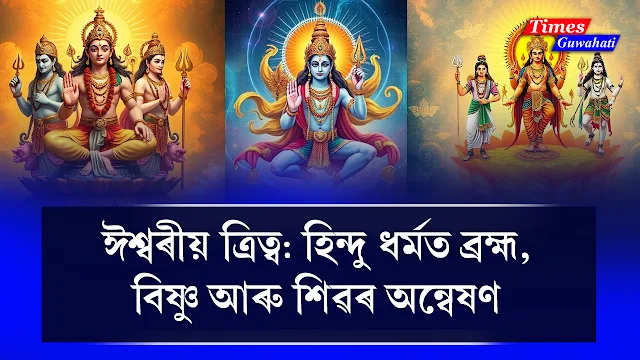The Divine Trinity: Exploring Brahma, Vishnu, and Shiva in Hinduism
Introduction
In Hinduism, the concept of the divine trinity—Brahma, Vishnu, and Shiva—represents the three fundamental aspects of the universe: creation, preservation, and destruction. This divine trio embodies the cosmic functions essential for the universe's cyclical nature, allowing creation, life, and transformation. Understanding the significance of Brahma, Vishnu, and Shiva offers insight into the depth of Hindu spirituality, philosophy, and their respective roles in maintaining balance within the cosmos.
Brahma: The Creator
English:
Brahma is recognized as the creator among the trinity. He is credited with creating the universe and all living beings. Depicted with four heads, each facing a different direction, Brahma symbolizes omniscience and the four Vedas. Despite his role, Brahma is less worshiped in comparison to Vishnu and Shiva, which stems from various legends explaining his diminished importance in religious practices.
Assamese (অসমীয়া):
ব্ৰহ্মা সৃষ্টি কৰ্ত্তা হিচাপে পৰিচিত। তেওঁ বিশ্ব আৰু সকলো জীৱিত বস্তু সৃষ্টি কৰাৰ বাবে জনাজাত। চাৰিজনী মূৰৰ সৈতে দৰ্শনীয় ব্ৰহ্মাই চাৰিসন্দিক চাই থাকে, যি তেওঁৰ চাৰিখন বেদৰ সৰ্বজ্ঞতাক প্ৰতিনিধিত্ব কৰে। যদিও তেওঁ সৃষ্টি কৰ্ত্তা, তদাপি ব্ৰহ্মাক তুলনামূলকভাৱে কম পূজা কৰা হয়, যাৰ পেছত বিভিন্ন দন্তকথা আছে।
Vishnu: The Preserver
English:
Lord Vishnu is revered as the preserver and protector of the universe. His primary role is to restore balance whenever there is a decline in righteousness. Vishnu is depicted with four arms, holding symbols like the conch, discus, mace, and lotus. He incarnates on earth in different forms, known as avatars, the most popular being Rama and Krishna.
Assamese (অসমীয়া):
ভগৱান বিষ্ণুক সংৰক্ষক আৰু ৰক্ষক হিচাপে পূজা কৰা হয়। তেওঁৰ মুখ্য ভূমিকা হৈছে ধৰ্মৰ অৱনতি হোৱা সময়ত সঠিকতা পুনঃস্থাপন কৰা। বিষ্ণুক চাৰিটা হাতৰ সৈতে দৰ্শন কৰা হয়, য'ত তেওঁ শঙ্খ, চক্র, গদা আৰু পদ্মধাৰণ কৰে। বিভিন্ন অৱতাৰ ৰূপত তেওঁ পৃথিৱীত অৱতৰণ কৰে, য'ত শ্ৰেষ্ঠ অৱতাৰ হ'ল ৰাম আৰু কৃষ্ণ।
Shiva: The Destroyer
English:
Shiva, known as the destroyer, embodies the transformative power of destruction. His role is essential in the process of creation, as destruction paves the way for new beginnings. He is often portrayed meditating on Mount Kailash or performing the cosmic dance, Tandava. Shiva is revered for his paradoxical qualities of wrath and benevolence.
Assamese (অসমীয়া):
শিৱাক বিনাশকাৰী বুলি জনা যায়। সৃষ্টি প্ৰক্ৰিয়াৰ বাবে বিনাশৰ একান্ত আৱশ্যক, যাৰ ফলত নতুন আৰম্ভণি সম্ভৱ হয়। শিৱক সাধাৰণতে কৈলাস পৰ্বতৰ ওপৰত ধ্যান কৰোঁতে বা তাণ্ডৱৰ নৃত্য কৰোঁতে দেখোৱা হয়। তেওৰ উগ্ৰতা আৰু কৰুণাৰ সমন্বয়ে তেওঁৰ পূজনীয় ৰূপ।
The Symbolism and Importance of the Trinity
English:
The divine trinity symbolizes the continuous cycle of the universe—birth, preservation, and destruction. This philosophical understanding emphasizes that life is ever-changing, with each phase necessary for progress. Devotees worship Brahma, Vishnu, and Shiva, acknowledging their roles in sustaining balance and guiding human evolution.
Assamese (অসমীয়া):
দেৱীয় ত্ৰিত্বই জন্ম, সংৰক্ষণ আৰু বিনাশৰ অনৱৰত পৰিক্ৰমাক প্ৰতিনিধিত্ব কৰে। এই দৰ্শনত্মক বোধৰ পৰা প্ৰমাণিত হয় যে জীৱন সদায় পৰিৱর্তিত, আৰু প্রতিটো পৰ্যায় উন্নতিৰ বাবে প্ৰয়োজন। উপাসকসকলে ব্ৰহ্মা, বিষ্ণু আৰু শিৱৰ পূজা কৰে, যাৰ মাজেৰে বিশ্বৰ সমতা বজাই ৰখা আৰু মানুহৰ উন্নতিৰ বাবে দৰ্শনীয় পথ প্ৰদৰ্শন কৰে।
Conclusion
English:
Brahma, Vishnu, and Shiva, as the divine trinity, signify the complex interplay of creation, preservation, and destruction. Their stories and teachings continue to inspire countless followers, shaping the spiritual and moral fabric of Hindu society.
Assamese (অসমীয়া):
ব্ৰহ্মা, বিষ্ণু আৰু শিৱ দেৱীয় ত্ৰিত্বৰূপে সৃষ্টি, সংৰক্ষণ আৰু বিনাশৰ জটিল সম্পৰ্কক প্ৰতিনিধিত্ব কৰে। তেওঁলোকৰ কাহিনী আৰু শিক্ষা বহুতো অনুসৰিসকলক অনুপ্ৰাণিত কৰি আহিছে, যিয়ে হিন্দু সমাজৰ আধ্যাত্মিক আৰু নৈতিক তন্ত্ৰ গঠনত সহায় কৰে।










